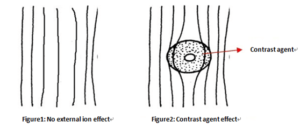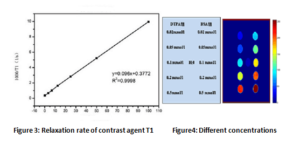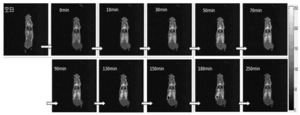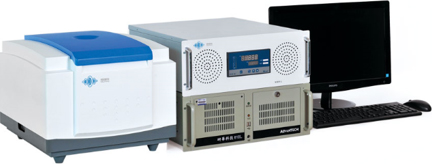Principles and Evaluation of Contrast Agents in NMR
본문
What is contrast agent?
Magnetic resonance imaging (MRI) is widely used in medical imaging and it has no radiation damage, also can be flexible tomography at any orientation. In addition, it can be applied in proton density, relaxation, weighted imaging and has the advantages of multi-parameter characteristics. Now MRI has become the most powerful means of detection. However, it is difficult to diagnose owing to the relaxation time overlap between some different tissue and tumors. So people began to study the MRI contrast agent to enhance the signal contrast and improve the image resolution. The contrast agent can change the tissue local relaxation characteristics; improve the imaging contrast, so that the accuracy of diagnosis will be improved.
Contrast agent is a kind of chemical synthesis material and the density is higher than living tissue. Contrast agent does not generate the signal, but objective to contrast by changing the H proton relaxation efficiency of local tissue.
The principle of contrast agent:
Some magnetic material has some unpaired electrons such as Fe, Mn or Gd. It can effectively change the proton magnetic field when these substances are close to the resonance of hydrogen atoms, making T1 and T2 relaxation time shorter. All in all, contrast agent can change the relaxation rate of local tissue H protons, improve the contrast and resolution between normal and diseased tissue, and provide more information for the diagnosis (as shown in Figure 1 and Figure 2).
MRI contrast agent can be divided into two types: paramagnetic and super-paramagnetic magnetic material, because it can interact with hydrogen nuclear. They inject to the animal’s body, changing the T1 relaxation rate (1 / T1) and T2 relaxation rate (1 / T2). The diamagnetic and paramagnetic contribution can be additive with the effect of paramagnetic magnetic material, namely:
(1/Ti) observation = (1/Ti) diamagnetic + (1/Ti) paramagnetic, ( i=1, 2).
The relaxation rate of the solvent is linearly related to the concentration (mol/L) of paramagnetic substance without the interaction of the different solute. i.e.:
(1/Ti) observation = (1/Ti) diamagnetic +addition ri [C], ( i=1, 2)
ri: Relativity, (unit: m mol / L and s)
The sums point at the types of contrast agent of the solution.
For example, T1 contrast agents, such as Gd complexes, image is bright and also is known as positive contrast agent; T2 contrast agents, such as based on ion of Fe3O4 super-paramagnetic magnetic contrast agents, image is dark and is known as negative contrast agent.

Application of contrast agent
Relaxation efficiency is one of the key indicators of MRI contrast agent. You can use the least high relaxation samples to achieve the best effect. In the field of contrast agent, NIUMAG specializes in the small nuclear magnetic resonance imaging analyzer, convenient for testing and measuring contrast agent T1 and T2 relaxation time, imaging the tube sample and providing quantitative and qualitative evaluation. Our company provides fast and reliable means of detection for contrast agent development and improvement.

Evaluation of contrast agents

By monitoring the metabolism process of the MRI contrast agent in the kidney, we can easily come to the conclusion. The metabolism time of the contrast agent in mice kidney is more than 250 min, and the most obvious effect shows at point about 130 min after injection.
In the field of biological medicine, low field NMR can provide the following research program:
1) Contrast agent study: evaluation of the effect of relaxation rate and metabolism in vivo;
2) Superficial tumor research: effect of contrast material, drug targeting and evaluation for tumor efficacy;
3) Research for tumor in situ: the investigation of the position, transfer and the size;
4) Analysis of body composition on awaked animals: the distribution of free water, Lean and Obese meat;


 TD-NMR/MRI
TD-NMR/MRI